Chords are three or more tones played in unison. They’re also referred to as harmony in music. They’re built upon the tones of scales and keys of music.
A Major chord on the piano is a series of three notes. It consists of the first, third and fifth tones of a Major key of music. The Major chord is also referred to as a Major triad. It’s a fundamental element of harmony in music.
The Anatomy of a Major Chord
Major chords, as well as any chord by definition, are constructed of intervals. Intervals are just the distances between notes. The main intervals used for chord construction are 3rds. This is known as tertian harmony (tertian meaning 3rd).
The Major chord is a derivative of a Major key of music. A Major key of music consists of a pattern of seven unique tones. This is also known as a Major scale.
When you play the first, third and fifth tones of the Major key, you have the tonic chord of that key.
For example here is the Key of C Major.
Key of C Major
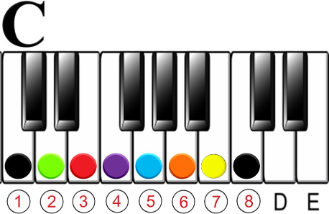
Playing the first, third and fifth tones give you the C Major chord. The first tone is also referred to as the root.
C Major Triad
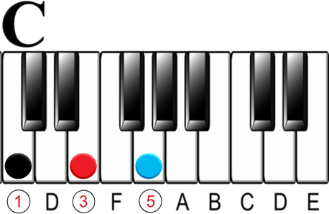
The key of F Major has seven unique tones also. The first, third and fifth tones give you the F Major chord.
Key of F Major
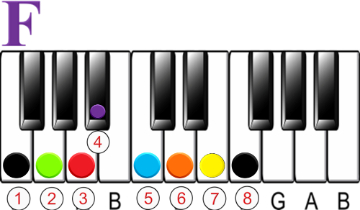
F Major Triad
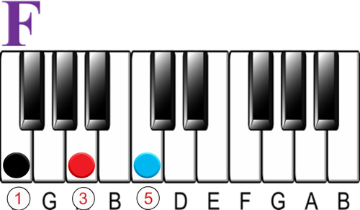
The key of G Major has seven unique tones. The first, third and fifth tones give you the G Major chord.
Key of G Major numbered
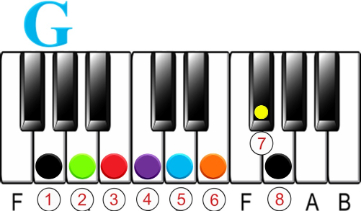
G Major Triad
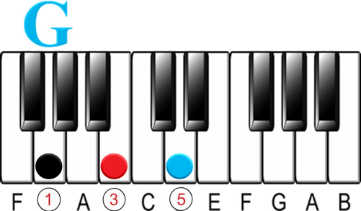
Major Chord Intervals
The intervals of the Major chord may be constructed of 3rds, but there are two kinds of 3rds.
There’s the Major 3rd and the minor 3rd.
A Major 3rd on the piano is any two keys that are separated by three keys. They can be in any combination of black and white keys.
C Major 3rd

A minor 3rd on the piano is any two keys that are separated by two keys. They can also be in any combination of black and white keys.
C minor 3rd

The Fastest Way to Learn the 12 Major Chords
Major chords have a visual character to them. This makes them very easy to learn. If you put Major chords into four groups of three, it’s simple to see their visual characteristics.
Let’s name the four categories of Major chords in visual order.
The “Marshmallow” chords
A marshmallow is white on the inside and white on the outside. These are the only three Major Triads that have all white keys.

The “Black Pepper Sandwich” Chords
A black pepper sandwich is white on the outside and black on the inside. You could also say that this group of chords is also shaped like a pyramid.

The “Oreo Cookie” Chords
Oreo Cookies are black on the outside and white on the inside. You could also say that these chords have the dimension of a funnel because the outside notes are high while the middle note is sunken in.

The “Chocolate & Vanilla Chunk” Chords
This group is known as the visual oddball of the Major Chords. No two of these chords look the same. For that reason, they fit in well together in this last group.

Major Chord Inversions
Even though the intervals and visual characteristics of Major chords are consistent, this is only when they’re in root position. In other words, when you see them as I’ve shown them here. The notes of the Major chord can be played in different positions known as inversions.
When Major chords are inverted, it changes their appearance but they are Major chords nonetheless. In order to learn Major chord inversions, it helps to recognize the location of the root of the chord.
In root position, the chord has a Major third between the root and 3rd and a minor 3rd between the 3rd and 5th. (as I described earlier)

In first inversion, the chord has a minor third between the 3rd and 5th tones and a perfect fourth between the 5th and the root. (A perfect four interval is two keys separated by four keys)

In Second inversion, the chord has a perfect fourth interval between the 5th and the root and a Major 3rd interval between the root and the 3rd.

Major Triads with Inversions
| Minor Chord | Root Position | 1st Inversion | 2nd Inversion |
| C Major | C-E-G | E-G-C | G-C-E |
| F Major | F-A-C | A-C-F | C-F-A |
| G Major | G-B-D | B-D-G | D-G-B |
| D Major | D-F#-A | F#-A-D | A-D-F# |
| E Major | E-G#-B | G#-B-E | B-E-G# |
| A Major | A-C#-E | C#-E-A | E-A-C# |
| D flat Major | Db-F-Ab | Fb-Ab-Db | Ab-Db-F |
| E flat Major | Eb-G-Bb | G-Bb-Eb | Bb-Eb-G |
| A flat Major | Ab-C-Eb | C-Eb-Ab | Eb-Ab-C |
| G flat Major | Gb-Bb-Db | Bb-Db-Gb | Db-Gb-Bb |
| B flat Major | Bb-D-F | D-F-Bb | F-Bb-D |
| B Major | B-D#-F# | D#-F#-B | F#-B-D# |
How to develop proficiency in learning and playing Major Chords
- Learn the structure of a Major chord
- Recognize the intervals of Major chords
- Study the 12 Major chords in visual order
- Take each Major chord and play it in Root position, 1st inversion and 2nd inversion
- Apply Major chords to your favorite music as well as your own songs
Final Thoughts
The key to becoming proficient with Major chords is to consistently develop your familiarity with them. Even though there are 12 Major chords, in essence there are only 12 of them. Even though there are different combinations of black and white keys, they all have the same structure. With repetition, you’ll develop the skills to play Major chords and advance well beyond them.
Until Next time, Go Play!
Greg Lee
Latest posts by Greg Lee (see all)
- What is a minor/Major 7 Chord? - October 26, 2023
- 7 Chord Substitutions that Professionals Use - October 19, 2023
- 5 Simple Chord Tricks to Sound Amazing - October 5, 2023



